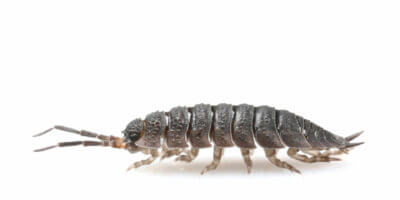Sowbug Facts & Information
Everything you need to know about sowbugs
What Do Sowbugs Look Like?

Sowbugs and pillbugs are similar-looking pests which are more closely akin to shrimp and crayfish than to insects. They are the only crustaceans that have adapted to living their entire life on land. Sowbugs and pillbugs range in size from 1/4 to 1/2 inch long and are dark to slate gray. Their oval, segmented bodies are convex above but flat or concave underneath. They possess seven pairs of legs and two pairs of antennae (only one pair of antennae is readily visible). Sowbugs also have two tail-like appendages which project out from the rear end of the body. Pillbugs have no posterior appendages and can roll up into a tight ball when disturbed, for which they are sometimes called “roly-polies.”
How did I get sowbugs?
Sowbugs may leave their natural habitats at night, and crawl about over sidewalks, patios, and foundations. They often invade crawl spaces, damp basements, and first floors of houses and businesses at ground level. Common points of entry into buildings include door thresholds (especially at the base of sliding glass doors), expansion joints, and through the voids of concrete block walls. Frequent sightings of these pests indoors usually means that there are large numbers breeding on the outside, close to the foundation. Since sowbugs require moisture, they do not survive indoors for more than a few days unless there are very moist or damp conditions.
Where do sowbugs live?
Sowbugs are scavengers and feed mainly on decaying organic matter. They occasionally feed on young plants, but the damage inflicted is seldom significant. If you do have young plants around your home, they could be there, making their way into your home or business by accident. Sowbugs thrive only in areas of high moisture and tend to remain hidden under objects during the day. Around buildings they are common under mulch, compost, boards, stones, flowerpots, and other items resting on damp ground. Another frequent hiding place is behind the grass edge adjoining sidewalks and foundations.
Problems caused
Sowbugs do not bite or spread disease. However, the sowbug is considered a nuisance pest indoors. Outdoors, they can cause damage to young plants. Mostly, you just don’t want them in your home or business and can give the perception that it’s less than clean. That’s a reputation killer whether it’s home for the holidays with family or guests coming into your business.
How can I prevent sowbugs?
The most effective, long-term measure for reducing indoor entry of sowbugs is to minimize moisture and hiding places near the foundation. Leaves, grass clippings, heavy accumulations of mulch, boards, stones, boxes, and similar items laying on the ground beside the foundation should be removed, since these often attract and harbor sowbugs. Items that cannot be removed should be elevated off the ground.
Don’t allow water to accumulate near the foundation or in your crawl spaces. Water should be diverted away from the foundation wall with properly functioning gutters, down spouts, and splash blocks. Leaking faucets, water pipes, and air conditioning units should be repaired, and lawn sprinklers should be adjusted to minimize puddling near the foundation. Homes with poor drainage may need to have tiles or drains installed, or the ground sloped to so that surface water drains away from the building. Humidity in crawl spaces and basements should be reduced by providing adequate ventilation, sump pumps, polyethylene soil covers, etc.
Don’t allow water to accumulate near the foundation or in your crawl spaces. Water should be diverted away from the foundation wall with properly functioning gutters, down spouts, and splash blocks. Leaking faucets, water pipes, and air conditioning units should be repaired, and lawn sprinklers should be adjusted to minimize puddling near the foundation. Homes with poor drainage may need to have tiles or drains installed, or the ground sloped to so that surface water drains away from the building. Humidity in crawl spaces and basements should be reduced by providing adequate ventilation, sump pumps, polyethylene soil covers, etc.
Why OPC?
We’re passionate about keeping sowbugs out of your home or business because we live and work here – it’s our neighborhood, too. We’ve been keeping homes and businesses in Kentucky, Ohio, Illinois, Indiana, and Wisconsin safe from pests since 1972. OPC Pest Services has the experience you can trust.
Expert pest control since 1972
Quality Pro certified company
Satisfaction guarantee
Need help with sowbugs?
GET MY QUOTE
“They always want to make sure the customer is satisfied. I have been with OPC for over 10 years. Highly recommend!”
Louisville, KY